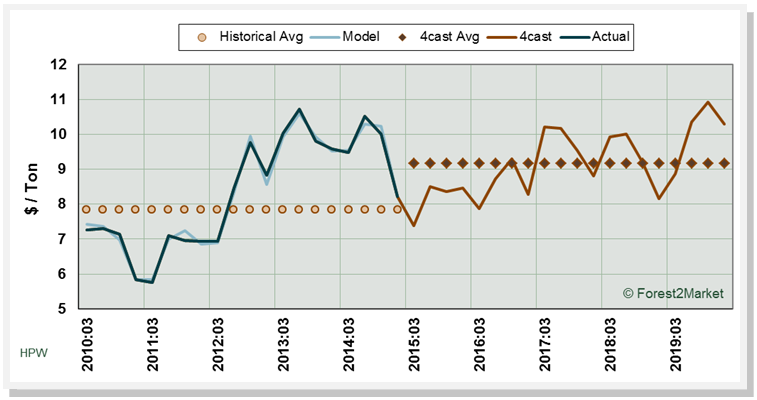3 min read
Accurate Forecasting: There Is No Substitute for a Precise Starting Point
 Pete Coutu
:
August 3, 2017
Pete Coutu
:
August 3, 2017

How much does the changing price of oil affect raw material cost? What impact will the changing value of the US dollar have on the future business environment? When the Federal Reserve changes interest rates, what effect will it have on business?
Changes like these affect the global business community. Regardless of the nature of the business, running it effectively requires the ability to think about, and plan for, the future. That’s why, if you are in the business of buying or selling wood raw materials, you forecast.
On the surface, price forecasting is a simple concept; you use historical data to project forward based on what you know about the future to establish likely scenarios. If you think markets will slow down next month, for instance, you will make one set of decisions. If you believe markets will pick up next month, on the other hand, you will make a different set of decisions.
Forecasting with a high degree of accuracy is a much more complex procedure involving a number of variables, some of them global and some of them local. As Nils Bohr, a Nobel laureate in Physics once said, "Prediction is very difficult, especially if it's about the future." One of the reasons for the difficulty associated with forecasting is the fact that interactions between global and local events must be taken into consideration.
A forecasting model must take both global and local and the interactions between the two into consideration. To build this model, Forest2Market uncovers statistically significant correlations between the transaction-level historical timber price data that we have been collecting since 2000, the economic indicators that affect demand (GDP, housing starts, etc.) and local events like rainfall that affect supply. We incorporate the future supply/demand scenarios and other applicable macroeconomic factors in order to develop the most likely outcome. The model fits all of these things, including the global and local dynamics, together to determine how and when prices will respond to changing influences.
Once the model is developed, the actual forecasting process begins. The quality of the forecast is highly dependent on the starting point. To produce an accurate forecast, the starting price (this month’s weighted average market price) should be based on the highest-quality transactional data in the forest products industry. By starting the process with a precise starting price based on the actual market, our forecasts deliver a greater level of accuracy that result in less variability over the forecast time period. The following chart highlights this accuracy: the light blue line shows our model’s forecast price, and the dark blue line shows actual timber prices.

Example: Historical and forecast of quarterly hardwood pulpwood stumpage prices
Applying the discipline of mathematical modeling to the rapidly-changing factors affecting prices is the only way to anticipate future timber prices. If you know with a high degree of confidence what you will pay for timber each month for the next 24 months, you can:
- Better optimize wood procurement – both volume and price
- Manage inventory (standing or in the yard) more effectively
- Align mill feedstock and output with raw material price trends
A business forecast built on Forest2Market’s robust, price-based datasets and business intelligence allows for greater accuracy because it is designed from a reliable, precise starting price. Forest2Market’s proprietary data allows for an unrivaled, comprehensive look at fiber and log markets, providing a precise starting point for a custom forecast. Mathematical models are the power tools needed to gain strategic advantage, operate efficiently and increase profits, and Forest2Market leverages these tools to provide the most comprehensive price-based forecasts in the industry.
These forecasts enable participants in the forest products industry to respond confidently to market changes while assuming a comfortable level of risk, and using a forecast model that can maximize return and minimize risk is simply smart business, especially in times of uncertainty.
To further enhance the data and analysis that Forest2Market provides its customers, we will be launching a new business intelligence platform later this year that will add an unparalleled, comprehensive view of the analytics that drive decision making and forecasting. The platform, SilvaStat360, will provide customers with access to Forest2Market’s extensive, proprietary regional datasets as well as current macroeconomic and market-related statistics. Subscribers will have the ability to use SilvaStat360’s data visualizations to filter and query data to answer specific market-related questions and to focus on those issues that affect forecasting and budgeting most directly.





